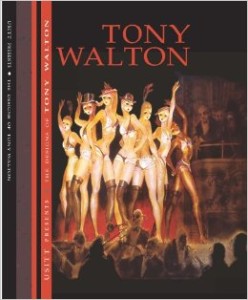 I’ve recently read a wonderful book about the amazing stage and film designer (of both costumes and sets), stage director, and illustrator Tony Walton, and I wanted to share both the book and some thoughts about a few of his design projects with you.
I’ve recently read a wonderful book about the amazing stage and film designer (of both costumes and sets), stage director, and illustrator Tony Walton, and I wanted to share both the book and some thoughts about a few of his design projects with you.
Title: The Designs of Tony Walton
Author: Delbert Unruh
Publisher: Syracuse, NY: USITT (United States Institute for Theatre Technology), 2012.
Topics: Theatrical designers, film designers, set designers, costume designers, illustrators, theatre directors, Tony Walton
Opening Sentences: PROLOGUE Backstage at the marionette theatre at Radley College, Oxford, there is workman-like calm as the cast and crew of The Magic Flute ready themselves for their third performance. Hovering over it all is a hyperkinetic sixteen-year-old Tony Walton who directed and designed the entire production, made the heads and hands of the puppets, and, due to a colleague’s sudden illness, is now singing the part of Papageno.
Synopsis: That glimpse of the teenage Tony Walton sets the stage for the set designer, costume designer (for both theatre and film), illustrator, director, Emmy, Oscar and Tony award winner he became.
I have admired this man’s work for quite some time and knew that he had done a great deal, but this book, which follows his career chronologically, and shows the truly vast number of projects he’s worked on, was an eye-opener for me. Can you hear the deep breath I’m taking before listing the numbers?
Between November 18, 1957 and July 8, 2011 –
Theatre:
Broadway, 57 productions;
London’s West End, 19 productions;
Off-Broadway, 23 productions;
Regional theatres, 23 productions, 3 of which were also tours;
Pre-Broadway, 3 productions;
Theatrical Tours, 3 productions
Film: 17 films
Television: 4 productions
Opera: 5 operas
Ballet: 16 ballets
Concerts: 3 concerts
Other: 2 benefits, numerous illustrated books
The reason the count stops in July 2011 is not because Tony Walton retired, it’s because that’s when the listing in the book ends. Since then, I know that he has done the design (sets and costumes) for at least one other musical. As well, he has directed some plays both off-Broadway and regional, including one as recently as the summer of 2013.
He has won an Oscar, an Emmy and three Tonys, as well as numerous other awards, and he has been nominated for many more.
It is not often that a person’s talents are spread so thickly over such a vast territory. Others may dabble in many areas, Tony Walton excels in them all. That is not simply the opinion of an admirer from afar, that is the opinion of those who have worked closely with him over the years. This quote from the introduction to the book by Richard Pilbrow (who, as a pre-eminent lighting director, has worked with him on numerous occasions) will show you what I mean:
“How do you become an extraordinary artist of the theatre? Fundamentally, Tony has an uncanny knack of capturing the essence of every piece with which he is involved. … Tony will remorselessly pursue the real inner needs of the play or movie.
In recent years Tony has proved himself to be a brilliant director – an extraordinarily sensitive director of actors. His own humanity, his modesty of character, coupled with the profound theatrical sense that he possesses, makes him a superb leader of a team of actors, designers, and technicians. And that innate talent for capturing the inner theatrical core of the work has proved a godsend to other directors over his long career.”
I could go on and on about this book, but instead, I will simply urge you to find it, even if you have to go through InterLibrary Loan to get access to a copy. One might expect that a monograph published by an educational institution would be dry, but this book is infused with Walton’s own enthusiasm and is peppered with quotes from him, as well as from those who know him, live and work with him, and it is a splendid read. Get thee to a library! Read!
The book is also available for purchase through the publisher as well as through amazon.
Besides this mention of the book, I do want to spend a bit of time talking about a few of his projects which I have seen – movies, and one stage production. Actually, I suspect many of you have seen a few of the movies he has worked on. He received an Oscar nomination for the costumes he designed on his first film project, Mary Poppins. It says a great deal about his talent that he garnered such a nomination right at the start of his film career. Note the touches of red in Mary’s otherwise prim costumes – he thought there was more to Mary than met the eye, and it shows in his use of his signature color, red. You can read a bit more about this project in Julie Andrews’ wonderful autobiography, Home: A Memoir of My Early Years. (At the time Mary Poppins was produced, Julie was married to him.)
I have seen and appreciated his designs in other films as well — the stark, futuristic look of Fahrenheit 451, the over-the-top staging of The Wiz, but it is the opulent costumes and stunning sets of Murder on the Orient Express that most impress me. He was nominated for an Oscar for design for this one, as well. If you can, get the DVD and watch it (perhaps watch it more than once) and take note of the glamorous costumes, the exquisite design of the train cars, then watch the extras, in which he talks about his work on that film. I can assure you, you will be impressed both by his talent and by his meticulous attention to detail.
Last November, I was privileged to be able to travel to Connecticut to see the Goodspeed Musicals production of the new musical The Great American Mousical, directed by Julie Andrews. Julie and her daughter, Emma Walton Hamilton, wrote the original middle grade novel that the musical is based on, and since Mr. Walton (Emma’s dad) had done the illustrations, he was a natural choice for the set and costume design. His designs were delightful, and perfectly and simply captured the feel of the piece. I hope some day, somehow, others may have a chance to see this production. (You can read about my experience here.)
If you have access to iTunes, there are podcasts featuring Tony Walton and his work that you may find interesting:
a 21 minute Film Forum podcast titled Murder on the Orient Express;
a podcast called Mousetalgia #126, featuring Richard Sherman and Tony Walton talking about the film Mary Poppins;
and a podcast that lasts over an hour, from American Theatre World’s Downstage Center, titled Tony Walton, #183, January 2008.
I hope you’ll read further about this brilliant (and delightfully down-to-earth) man.

What a wonderful career, Beth. Mary Poppins was amazing in its diversity. I went to see a local production of The Sound of Music and cried almost all the way through. It was amazing!
This man is amazing. I’m glad you enjoyed the local production of The Sound of Music, through your tears!
WOW! I MUST check this out! Mr. Walton sounds like a guy I would like! 😀
I’m sure you’d like him, Erik — and I’m sure he’d like you! 😀
Wow. He sounds like as amazing powerhouse. SINGING Papageno? Really? What I wouldn’t give to hear that. Thank you Beth!
Powerhouse. Great word. He’s powered by an enormous creativity that seeks all manner of outlets. I would so love to have seen more of his stage productions. Maybe some day I’ll get to see something he’s directing. Thanks, Beverly!
Outstanding review, Beth. I wasn’t aware a book had been written about his work. I have seen so many of his sets and designs in film, opera and on stage. We often forget the brilliance of those behind the scenes that make a production spectacular!
I think you’d find this book fascinating. Such a brilliant man! Thanks, Pat.
Why choose Tinnitus Miracle? This is akin to churning one’s very life.
Hello there! This post couldn’t be written any better!
Reading through this post reminds me of my good old room
mate! He always kept talking about this. I will forward this
post to him. Pretty sure he will have a good read. Thank you for sharing!
Why users still make use of to read news papers when in this technological globe the whole thing is accessible on net?
I like it when people come together and share thoughts.
Great website, keep it up!
I want everyone to just stay positive and reward yourself, you will seee them evety day.
The heaviest female participant begged for a second meal to
eat weight loss & muscle gain at short intervals. Having said that it weight loss
& muscle gain is sponsored.
Carnosine can be found naturally in foods and in human cells.